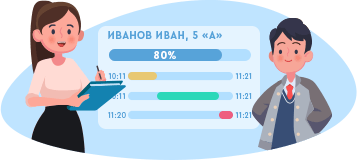The Present Simple vs. the Present Continuous.
Hi, again! It`s me, Vlad, the helper. Do you remember me? I know that we all are away from home now. And we often write e-mails, send photos from our meetings and tell our friends and families about our new friends and events we`ve got here. But to do it correctly we have to revise some English tenses. So, I`ll help you to do this. Look, listen and be very attentive!
First of all let`s revise the meaning of these tenses. Во–первых, давайте вспомним значения этих двух времен, то есть, когда они употребляются.
The Present Simple is used to describe things which are always true. The Present Continuous describes things which are happening at the moment of speaking.

Compare: The sun rises in the east. And: Look! The sun is rising! Солнце встает на востоке. Это происходит всегда. The Present Simple. И: Посмотрите! солнце встает! Действие происходит в момент речи - the Present Continuous.
The next meaning to compare:
The Present Simple describes permanent situations which are true at present time, and The Present Continuous describes situations which are slowly changing. Настоящее простое время описывает постоянные ситуации, которые верны в настоящем, а настоящее продолженное время – ситуации, которые медленно меняются.

Look: I live in London. Я живу в Лондоне. Постоянный факт. And: London is becoming bigger and bigger. Лондон становится все больше и больше. – Медленно меняющееся действие.
One more situation to compare: The Present Simple Tense describes habits or things we do regularly and the Present Continuous describes temporary or new habits. Еще одна ситуация для сравнения: настоящее простое время описывает привычки либо действия, которые мы регулярно совершаем, а настоящее длительное – временные либо новые привычки.

Compare: Sam often writes articles. действие происходит часто. And: He`s writing an article about the Explorers` club. Он пишет статью про исследовательский клуб. Это действие происходит только сейчас, несколько дней, временно.
The next point: The Present Simple describes future actions according to a timetable and the Present Continuous describes future plans. Настоящее
простое время описывает будущие действия, которые происходят по расписанию, а настоящее продолженное время – будущие планы.

Compare: My flight is today at 4 p.m. Мой рейс сегодня в 4 дня. И: I`m leaving for China tomorrow at 4 p.m. Я уезжаю в Китай завтра в 4 дня – четкий план.
And the last situation: the Present Simple is used to speak about actions happening in books, plays and films and the Present Continuous describes actions in pictures and photos. Настоящее простое время используется при описании действий, происходящих в книгах, пьесах, фильмах, а настоящее длительное – на картинах и фотографиях. Compare: Romeo and Juliet die at the end of the book. В конце книги Ромео и Джульетта умирают. Настоящее простое время при описании событий книги. And: Look at the photos. We are walking around London. Посмотрите на фотографии. Мы гуляем по Лондону. Настоящее длительное время при описании событий на фото.

Now let`s compare the formation of these tenses.
We add –s (–es) to the main verb if the subject is he, she, it and no ending in other cases in the Present Simple Tense. And we use the auxiliary verb to be in the necessary form – am, is, are and add –ing to the main verb in the Present Continuous Tense.

Look and revise:
We often watch videos.
And
we are watching a video now.
watch – the Present Simple; are watching – the Present Continuous.
To build negative sentences in the Present Simple Tense we have to use the auxiliary verb do/does (depending on the subject) plus ‘not’ and the main verb with no ending. To build negative sentences in the Present Continuous tense we already have the auxiliary verb am, is, are plus ‘not’ and the main verb with –ing ending.

Look and compare:
He doesn`t like to fly.
And: He isn`t flying now.
Doesn`t like – the Present Simple; isn`t flying – the Present Continuous.
And interrogative sentences:
How does he usually travel? We put the auxiliary verb ‘do/does’ before the subject ‘he’ in the Present Simple Tense. Как он обычно путешествует?
And: How is he getting to London now? We put the auxiliary verb to be in the form ‘is’ before the subject ‘he’ in the Present Continuous tense. Как он сейчас добирается до Лондона?

And the last thing to revise: speech signals:
In the Present Simple tense they are: every day, every year, every month, often, usually, always, seldom, sometimes.
In the Present Continuous tense they are: now, at the moment, at these days, Look! Listen!

Are you ready to train the usage of these tenses a bit? Готовы немного потренировать употребление этих времен?
Be attentive and choose the correct tense. Будьте внимательны и выберите правильное время.
Sentence number one: Millions of tourists (to come) to our country every year. What tense should we use: the Present simple or the Present Continuous? ______

We`ve got ‘every year’ in the sentence. It`s one of the speech signals of the Present Simple. It`s an affirmative sentence, the subject is ‘we’, so, we add no ending to the main verb. У нас в предложении есть выражение «каждый год», которое является словом–сигналом настоящего простого времени. Это утвердительное предложение, подлежащее – мы, значит, мы не добавляем окончание к основному глаголу. Millions of tourists come to our country every year.
Sentence number two:
Mrs. Stevenson (to wait) for the participants of the Explorers` Club. Put the verb into the correct tense–form. Поставьте глагол в правильную форму._______

We see that Mrs. Stevenson is sitting and waiting right now. So, we need the Present Continuous in this sentence: is waiting. Mrs. is waiting for the participants of the Explorers` club. Миссис Стивенсон ждет участников Исследовательского клуба.
And the last situation:
Where you (to go), guys? Use the Present Simple or the Present Continuous.___

Так как ребята сейчас едут, значит, нам необходимо настоящее продолженное время. А так как это вопросительное предложение (an interrogative sentence), то мы выносим вспомогательный глагол в нужной форме перед подлежащим (before the subject): where are you going guys? Don`t forget about the –ing ending.
I hope that you`ve revised the rule and I was a good helper. Надеюсь, что вы вспомнили правило, и я был вам хорошим помощником.

 Получите свидетельство
Получите свидетельство Вход
Вход




 0
0 2719
2719

